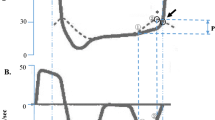Summary
The time at which the contractile elements (CE) of heart muscle are capable of shortening with maximum velocity at zero load (V max) has been derived from isotonic contractions at increasing afterloads in the papillary muscle of the cat. The time interval from the stimulation to peak velocity of shortening of isotonic contractions at increasing afterloads was found to be a linear function of load with a highly significant correlation (r>0.99). Thus, the intercept of this function with the time axis at zero load provides an estimate of the time of the onset ofV max. It has been calculated that theV max sets in very early during the course of the contraction at only 20% of the time from stimulation to peak isometric tension both in control conditions and following various inotropic interventions. Thus in heart muscle the early ability of the CE to shorten with maximum velocity at zero load (V max) has to be dissociated from the course of the active state in terms of force resistance to stretch.
Similar content being viewed by others
References
Abbott, B. C., Ritchie, J. M.: The onset of shortening in striated muscle. J. Physiol. (Lond.)113, 336–345 (1951).
Brady, A. J.: Time and displacement dependence of cardiac contractility: Problems in defining the active state and force-velocity relations. Fed. Proc.24, 1410–1420 (1965).
Brutsaert, D. L., Claes, V. A., Sonnenblick, E. H.: Effects of abrupt load alterations on force-velocity-length and time relations during isotonic contractions of heart muscle: load clamping. Submitted for publication.
—, Sonnenblick, E. H.: Force-velocity-length-time relations of the contractile elements in heart muscle of the cat. Circulat. Res.24, 137–149 (1969).
Edman, K. A. P., Nilsson, E.: Mechanical parameters of myocardial contraction studied at a constant length of the contractile element. Acta physiol. scand.72, 205–219 (1968).
Gasser, H., Hill, A. V.: The dynamics of muscular contraction. Proc. roy. Soc. B96, 398–437 (1924).
Hill, A. V.: The abrupt transition from rest to activity in muscle. Proc. roy. Soc. B136, 399–420 (1949).
—: The transition from rest to full activity in muscle: The velocity of shortening Proc. roy. Soc. B138, 329–338 (1951).
—: First and last experiments in muscle mechanics. London: Cambridge University Press 1970.
Huxley, A. F.: Muscle structure and theories of contraction. Progr. biophys. Chem.7, 255–318 (1957).
Jewell, B. R., Wilkie, D. R.: The mechanical properties of relaxing muscle. J. Physiol. (Lond.)152, 30–47 (1960).
Noble, M. I. M., Bowen, T. E., Hefner, L. L.: Force-velocity relationship of cat cardiac muscle, studied by isotonic and quick-release technique. Circulat. Res.24, 821–833 (1969).
Parmley, W. W., Brutsaert, D. L., Sonnenblick, E. H.: The effects of altered loading on contractile events in isolated cat papillary muscle. Circulat. Res.24, 521–532 (1969).
Pollack, G. H.: Maximum velocity as an index of contractility in cardiac muscle. Circulat. Res.26, 111–127 (1970).
Ritchie, J. M.: The relation between force and velocity of shortening in rat muscle. J. Physiol. (Lond.)123, 633–639 (1954).
— Wilkie, D. R.: The dynamics of muscular contraction. J. Physiol. (Lond.)143, 104–113 (1958).
Sonnenblick, E. H.: Determinants of active state in heart muscle: Force, velocity, instantaneous muscle length, time. Fed. Proc.24, 1396–1409 (1965).
—: Active state in heart muscle: Its delayed onset and modification by inotropic agents. J. gen. Physiol.50, 661–676 (1967).
Author information
Authors and Affiliations
Rights and permissions
About this article
Cite this article
Brutsaert, D.L., Sonnenblick, E.H. The early onset of maximum velocity of shortening in heart muscle of the cat. Pflugers Arch. 324, 91–99 (1971). https://doi.org/10.1007/BF00592655
Received:
Issue Date:
DOI: https://doi.org/10.1007/BF00592655




